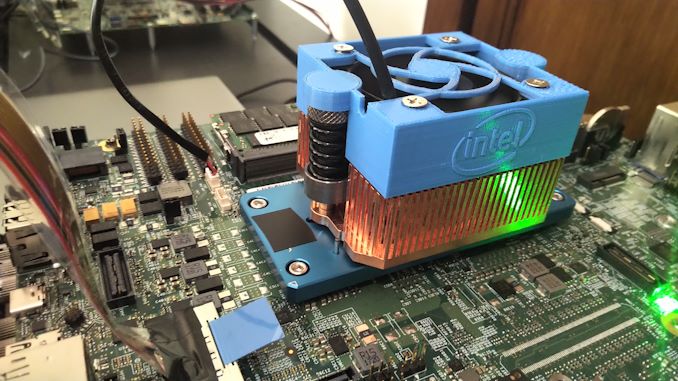Intel's Architecture Day 2018: The Future of Core, Intel GPUs, 10nm, and Hybrid x86
by Dr. Ian Cutress on December 12, 2018 9:00 AM EST- Posted in
- CPUs
- Memory
- Intel
- GPUs
- DRAM
- Architecture
- Microarchitecture
- Xe
Demonstrating Sunny Cove and Gen11 Graphics
As part of the Architecture Event, Intel ran a number of demos on a chip that was supposedly based on the new Sunny Cove cores and Gen11 graphics.
These were development systems with these funky looking heatsinks and loud fans to ensure there was no thermal throttling. One thing worth noticing is that black bit of tape on the heatsink here, which wasn’t present on one of the other demo units.
Hello Ice Lake-U. Being a U-series heatsink, this means that the Core is likely designed for a 15W scenario.
Perhaps it’s no surprise that Intel wasn’t giving anything away in terms of the exact core count on display, speeds, feeds, and power. The demos that were present involved 7-Zip and gaming.
The 7-Zip demo was relatively straight forward, showing how the new instructions such as Vector-AES and SHA-NI in Sunny Cove can give the processor a 75% boost in performance over an equivalent Skylake based platform at iso-frequency. This falls under the ‘specialist’ improvements to the core rather than the general purpose improvements.
The other demo was Tekken 7, being run on a Sunny Cove + Gen11 machine and compared to a Skylake + Gen9 implementation. It looked a good deal smoother that’s for sure, however it was clear that it had some way to go to be fully out of the 30 FPS minimums.














148 Comments
View All Comments
nathanddrews - Wednesday, December 12, 2018 - link
I know the meme about gaming on Intel graphics, but if they implement Adaptive Sync *combined* with some sort of low framerate compensation, it would make gaming on Intel IGP much less hilarious. Can Intel license FreeSync without using AMD GPU inside? I know FreeSync worked on KLG, but that had an AMD GPU.RarG123 - Wednesday, December 12, 2018 - link
Like many of AMD's things, FS's an open standard and royalty free. Anyone can use it.Ryan Smith - Wednesday, December 12, 2018 - link
More specifically, Freesync 1 just AMD's implementation of DisplayPort Adaptive Sync. Intel has to build their own implementation in their display controller and driver stack, but past that all the signaling aspects to the monitor are standardized.Topweasel - Wednesday, December 12, 2018 - link
Ryan, I thought that was reversed, that AMD worked on adding Adaptive Sync into the specs and worked on making sure it's implementation matched what they were doing with Freesync.kpb321 - Wednesday, December 12, 2018 - link
IIRC it's a bit of both. Adaptive Sync was present in the eDP standard for things like laptop monitors or tablets as a power saving feature. AMD brought this to the desktop side of things to use for variable framerates in games and helped the standard bring it over too.edzieba - Wednesday, December 12, 2018 - link
'Adaptive Sync' is effectively the eDP Panel Self Refresh ported over to the full DP spec.drunkenmaster - Wednesday, December 12, 2018 - link
Freesync utilises adaptive sync. Adaptive Sync is the technology on the screen side, a screen must support adaptive sync to be used by Freesync. Freesync is just the AMD side of it. If a adaptive sync capable screen is detected you can turn on freesync in drivers. Adaptive sync was a standard written up and proposed by AMD and given to I forget who it is now, Displayport group direct or to Vesa. They accepted it and implemented it pretty quickly but as with all things standards take a long time for get integrated into the next cycle or two of products.Anyone can use Adaptive sync panels, no one but AMD can use freesync as it's something specific to their hardware and drivers. intel will produce their own specific driver/implementation and just connected to adaptive sync panels in the same way.
porcupineLTD - Wednesday, December 12, 2018 - link
So Intel is going straight to chiplets on interposer, it will be interesting to see if AMD adopts this with Zen 3 or waits until Zen 4. Anyway its nice to see competition doing its job.Alexvrb - Wednesday, December 12, 2018 - link
We don't know yet exactly how much logic Intel is moving to the interposer. It looks awesome for mobile form factors! I think they will face some challenges to bring it to high-TDP desktop solutions, though.ajc9988 - Wednesday, December 12, 2018 - link
http://www.eecg.toronto.edu/~enright/micro14-inter... http://www.eecg.toronto.edu/~enright/Kannan_MICRO4... https://youtu.be/G3kGSbWFig4 https://seal.ece.ucsb.edu/sites/seal.ece.ucsb.edu/... https://www.youtube.com/watch?v=d3RVwLa3EmM&t=...